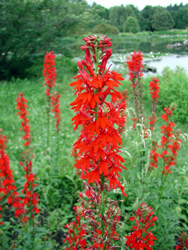Resource Library
Plant of the Week: Cardinal Flower
The University of Arkansas System Division of Agriculture does not promote, support or recommend plants featured in "Plant of the Week." Please consult your local Extension office for plants suitable for your region.
Plant of the Week
Cardinal Flower
Latin: Lobielia cardinalis

Having just returned from a fieldtrip with a number of botanists, I now have more appreciation for this special breed of scientists. What I found most amazing, and frankly puzzling, was their collective excitement at finding some obscure, tiny and often ugly flower most gardeners wouldn't give a second look. But even scientists can have their heads turned by a pretty face. They all seem to like Cardinal flower (Lobelia cardinalis).
Cardinal flower is a native perennial growing 3- to 4-feet tall and producing intense scarlet blooms in late summer and fall at the end of unbranched stems. Over winter, plants die back to an evergreen clump that sees the plant through the winter. The leaves are smooth (glabrous) and often purple or maroon tinged and to 4 inches long. Lobelia belongs to the bluebell family.
Individual blooms of cardinal flower are tubular with three broad prominently displayed petals and two more slender, upturned petals that remind me of the ears on Batman's mask. Protruding from each flower are the sexual parts of the flower that are strategically placed to distribute pollen when visited by ruby throated hummingbirds as they make their rounds.
In a survey of botanists in the middle of the last century cardinal flower was listed as their favorite flower. Like most surveys, this one seems to have a fatal flaw. It required that botanists choose from the plants that grew locally, so obviously any plant with a broad distribution had a leg up. Cardinal flower had the advantage of a showy presence and a wide range from eastern Canada to California and south through Mexico to northern Columbia. Though it has a wide range it favors wet, wild places so it doesn't suffer the stigma of being too common in any locale.
Lobelia was introduced to Europe by the English plant collector John Tradescant in 1626.
The genus was named for the Flemish botanist Mathias de l'Obel (1538 - 1616) who wrote under the Latinized form of his name Lobelius. The common name came not from our native bird, but from the scarlet vestments worn by high-ranking officials of the Catholic Church.
Of late, attempts have been made to domesticate the cardinal flower by crossing it with several other species in an attempt to extend the color range and increase the flower size. The first of these three way European hybrids appeared in the early 1990s as the "Fan Series" using L. siphilitica (blue) and L. fulgens (red). A hybrid with Mexican lobelia (L. fulgens) called "Queen Victoria" has maroon foliage and is less winter hardy.
Cardinal flowers have few specific requirements as to soil type other than one critical need; moisture. In nature it is a bog or streamside plant, so don't expect this to survive in the typical dry border where it is forced to compete with other garden perennials. It will grow in full sun or partial shade but is perhaps at its best in sites with full sun until mid-afternoon when some natural shade is provided by a structure or a tree canopy. Queen Victoria can be grown directly in a water garden. Some plant cardinal flowers at the base of a downspout so they are watered with every shower.
If well-sited cardinal flowers will form individual clumps the first year and then form a small colony as slender rhizomes spread it about. It will also reseed in moist sites. The species is hardy from zones 3 through 9 but the hybrids are only hardy through zone 7. Individual plants are usually short lived but in good locations will reseed freely.
By: Gerald Klingaman, retired
Extension Horticulturist - Ornamentals
Extension News - September 25, 2009
The University of Arkansas System Division of Agriculture does not maintain lists of retail outlets where these plants can be purchased. Please check your local nursery or other retail outlets to ask about the availability of these plants for your growing area.